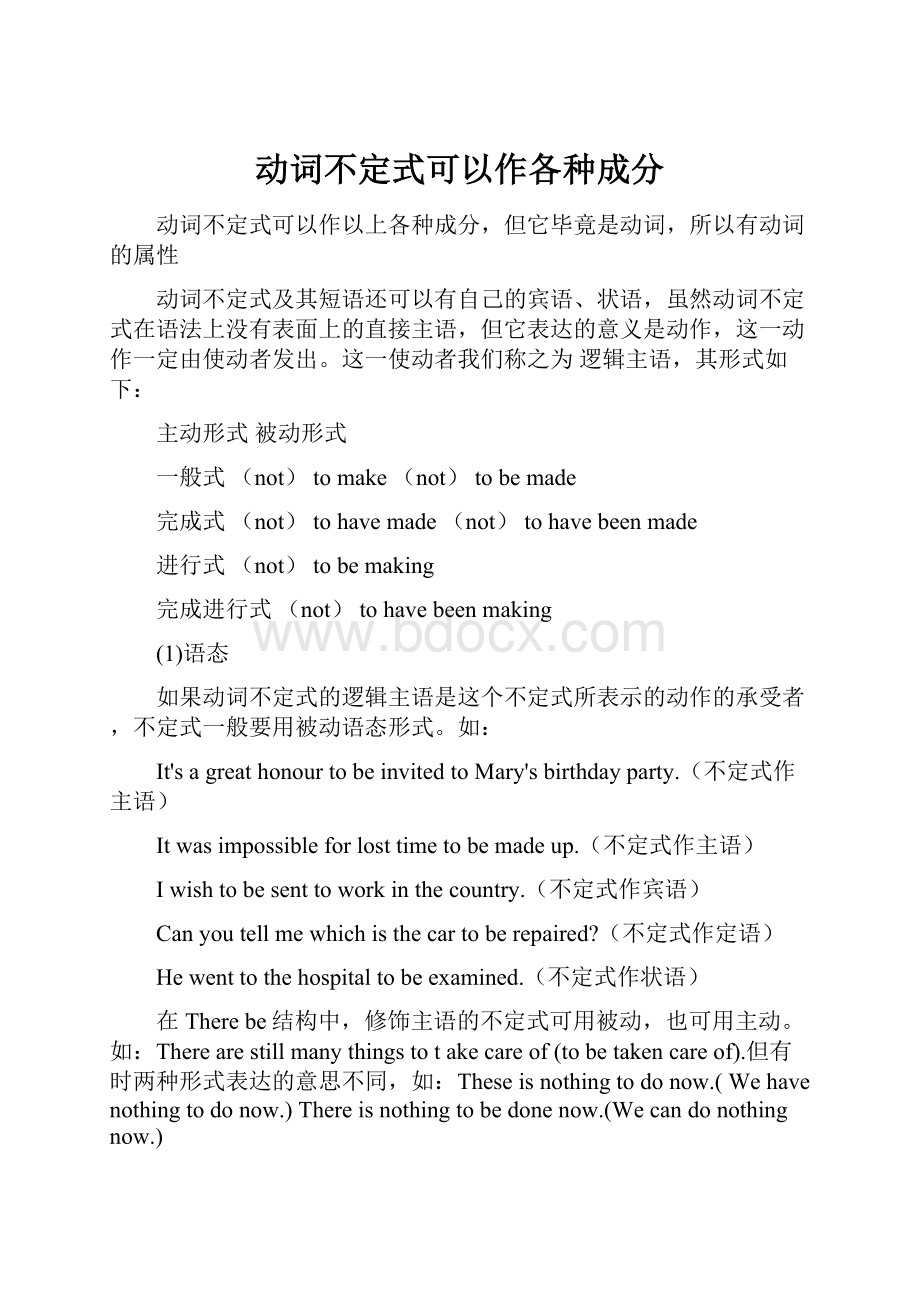动词不定式可以作各种成分.docx
《动词不定式可以作各种成分.docx》由会员分享,可在线阅读,更多相关《动词不定式可以作各种成分.docx(12页珍藏版)》请在冰豆网上搜索。

动词不定式可以作各种成分
动词不定式可以作以上各种成分,但它毕竟是动词,所以有动词的属性
动词不定式及其短语还可以有自己的宾语、状语,虽然动词不定式在语法上没有表面上的直接主语,但它表达的意义是动作,这一动作一定由使动者发出。
这一使动者我们称之为逻辑主语,其形式如下:
主动形式被动形式
一般式(not)tomake(not)tobemade
完成式(not)tohavemade(not)tohavebeenmade
进行式(not)tobemaking
完成进行式(not)tohavebeenmaking
(1)语态
如果动词不定式的逻辑主语是这个不定式所表示的动作的承受者,不定式一般要用被动语态形式。
如:
It'sagreathonourtobeinvitedtoMary'sbirthdayparty.(不定式作主语)
Itwasimpossibleforlosttimetobemadeup.(不定式作主语)
Iwishtobesenttoworkinthecountry.(不定式作宾语)
Canyoutellmewhichisthecartoberepaired?
(不定式作定语)
Hewenttothehospitaltobeexamined.(不定式作状语)
在Therebe结构中,修饰主语的不定式可用被动,也可用主动。
如:
Therearestillmanythingstotakecareof(tobetakencareof).但有时两种形式表达的意思不同,如:
Theseisnothingtodonow.(Wehavenothingtodonow.)Thereisnothingtobedonenow.(Wecandonothingnow.)
(2)时态
1)现在时:
一般现在时表示的动词,有时与谓语动词表示的动作同时发生,有时发生在谓语动词的动作之后。
Heseemstoknowthis.
Ihopetoseeyouagain.=IhopethatI'llseeyouagain.我希望再见到你。
2)完成时:
表示的动作发生在谓语动词表示的动作之前。
I'msorrytohavegivenyousomuchtrouble.
Heseemstohavecaughtacold.
3)进行时:
表示动作正在进行,与谓语动词表示的动作同时发生。
Heseemstobeeatingsomething.
4)完成进行时:
Sheisknowntohavebeenwreakingontheproblemformanyyears.
疑问词+不定式结构
疑问词who,what,which,when,where,whether,how后可接不定式构成不定式短语,在句中作主语、宾语、表语等。
如:
①WhentoleaveforLondonhasnotbeendecidedyet.
②Mr.Smithdidn'tknowwhethertoleaveorstaythere.
③IaskedProfessorXuhowtolearnEnglishwell.
④Thequestionwaswheretogetthemedicineneeded.
以上例句中疑问词+不定式部分,均可转换为相应的从句形式。
如:
①Whenweshallleave…③…howI
couldlearn…
经常在这种结构中使用的动词有:
consider,decide,discover,explain,findout,forget,hear,know,learn,observe,understand,wonder等。
动词不定式的语法功能
一、作宾语
1)动词+不定式
affordaimappearagreearrangeaskbedecidebothercarechoosecomedaredemanddesiredetermineexpectelectendeavorhopefailhappenhelphesitatelearnlongmeanmanageofferoughtplanpreparepretendpromiserefuseseemtendwaitwishundertake
举例:
Thedriverfailedtoseetheothercarintime.
司机没能及时看见另一辆车。
Ihappentoknowtheanswertoyourquestion.
我碰巧知道你那道问题的答案。
2)动词+不定式;动词+宾语+不定式
ask,beg,choose,expect,hate,helpintendlike,love,needprefer,prepare,promise,want,wish…
Iliketokeepeverythingtidy.我喜欢每件东西都保持整洁。
Ilikeyoutokeepeverythingtidy.我喜欢你年使每件东西都保持整洁。
IwanttospeaktoTom.我想和汤姆谈话。
IwantyoutospeaktoTom.我想让你和汤姆谈话。
3)动词+疑问词+to
decide,know,considerforget,learn,remember,show,understand,see,wonder,hear,findout,explain,tell
Pleaseshowushowtodothat.请演示给我们如何去做。
Therearesomanykindsoftape-recordersonsalethatIcan'tmakeupmymindwhichtobuy.有这么多的录音机,我都拿不定主意买哪一种。
注意:
疑问词带不定式在句中作成分时,谓语动词用单数。
Thequestionishowtoputitintopractice.
问题是怎样把它付诸实施。
4)以下动词后,只能跟不定式作宾语。
如:
agree,ask,aim,arrange,choose,decide,demand,expect,fail,help,hope,lean,long,manage,offer,plan,prepare,
pretend,promise,refuse,wish等,这些词大部分可接that引导的从句。
如:
Idecidedtoaskformymoneyback.
IdecidedthatIwouldaskformymoneyback.
Whenourvisittothefarmwasover,weexpectedtostartbackonfoot.
Whenourvisittothefarmwasover,weexpectedthatwewouldstartbackonfoot.
5)当复合宾语中的宾语是不定式时,先用形式宾语it代替不定式,把不定式置于补语之后,即:
主语+动词+it+补语+todo句式。
如:
Wethinkitquiteimportantforustolearnaforeignlanguagewell.
Hefeelsithisdutytohelpthepoor.
二、作补语
1)动词+宾语+不定式(todo)
adviseallowappointbelievecausechallengecommandcompelconsiderdeclaredriveenableencouragefindforbidforceguesshireimagineimpelinduceinforminstructinvitejudgeknowlikeorderpermitpersuaderemindreportrequestrequireselectsendstatesupposetellthinktraintrustunderstandurgewarn
例句:
a.Fatherwillnotallowustoplayonthestreet.
父亲不让我们在街上玩耍。
b.Webelievehimtobeguilty.
我们相信他是有罪的。
Find的特殊用法:
Find后可用分词做宾补,或先加形式宾语,再加形容词,最后加带to的动词不定式。
find后也可带一个从句。
此类动词还有get,have。
Ifoundhimlyingontheground.
Ifounditimportanttolearn.
IfoundthattolearnEnglishisimportant.
典型例题:
Thenextmorningshefoundtheman___inbed,dead.
A.lyingB.lieC.layD.laying
答案:
A.find的宾语后面,用分词或分词短语,起宾语补足语作用。
现在分词表达主动,也表达正在进行,过去分词表达被动。
2)to+be的不定式结构,作补语的动词。
Acknowledge,believe,consider,think,declare(声称),discover,fancy(设想),feelfind,guess,judge,imagine,know,prove,see(理解),show,suppose,take(以为),understand
WeconsiderTomtobeoneofthebeststudentsinourclass.
我们认为汤姆是班上最好的学生之一。
典型例题
CharlesBabbageisgenerallyconsidered___thefirstcomputer.
A.toinventB.inventingC.tohaveinventedD.havinginvented
答案:
A.由considertodosth.排除B、D。
.此句只说明发明这一个事实,不定式后用原形即可。
而C为现在完成时,发明为点动词一般不用完成时,且此处也不强调对现在的影响,因此不选C。
3)tobe+形容词
Seem,appear,besaid,besupposed,bebelieved,bethought,beknown,bereported,hope,wish,desire,want,plan,expect,mean…
Thebookisbelievedtobeuninteresting.
人们认为这本书没什么意思。
4)therebe+不定式
believe,expect,intend,like,love,mean,prefer,want,wish,undrstand
Wedidn'texpecttheretobesomanypeoplethere.我们没料到会有那么多人在哪里。
有些动词需用as短语做补语,如regard,thinkbelieve,take,consider.
WeregardTomasourbestteacher.我们认为汤姆是我们最好的老师。
Marytookhimasherfather.玛丽把他当作自己的父亲。
三、作主语
动词不定式作主语时,句子的谓语动词常用单数,其位置有以下两种:
(1)把不定式置于句首。
如:
Togettherebybikewilltakeushalfanhour.
(2)用it作形式主语,把真正的主语不定式置于句后,常用于下列句式中。
如:
①It+be+名词+todo
It'sourdutytotakegoodcareoftheold.
②Ittakessb+sometime+todo
Howlongdidittakeyoutofinishthework?
③It+be+形容词+forsb+todo
Itisdifficultforustofinishwritingthecompositioninaquarterofanhour.
④It+be+形容词+ofsb+todo
Itisstupidofyoutowritedowneverythingtheteachersays.
⑤Itseems(appears)+形容词+todo
Itseemedimpossibletosavemoney.
在句型③中,常用表示客观情况的形容词,如:
difficult,easy,hard,important,impossible,necessary等;在句型④中,常用careless,clever,good,foolish,honest,kind,lazy,nice,right,silly,stupid,wise等表示赞扬或批评的词。
在不定式前的sb,可看作其逻辑主语。
这一句式有时相当于Sbis+形容词+todo句式,如:
It'skindofyoutohelpmewithmyEnglish.=YouarekindtohelpmewithmyEnglish.
(3)举例
1)It'seasy(forme)todothat.我做这事太容易了
easy,difficult,hard,important,possible,impossible,comfortable,necessary,better;
thefirst,thenext,thelast,thebest,toomuch,toolittle,notenough
It'ssonicetohearyourvoice.
听到你的声音真高兴。
It'snecessaryforyoutolockthecarwhenyoudonotuseit.
当你不用车的时候,锁车是有必要的。
2)It'sverykindofyoutohelpus.他帮助我们,他真好。
Kind,nice,stupid,rude,clever,foolish,thoughtful,thoughtless,brave,considerate(考虑周到的),silly,selfish(自私的)
例句:
Itwassillyofustobelievehim.我们真愚蠢,竟然相信了他。
Itseemedselfishofhimnottogivethemanything.他不给他们任何东西,这显得太自私了。
注意:
1)其他系动词如,look,appear等也可用于此句型
2)不定式作为句子成分时,动词用单数形式。
3)当不定式作主语的句子中又有一个不定式作表语时,不能用Itis…to…的句型
(对)Toseeistobelieve.百闻不如一见。
(错)Itistobelievetosee.
四、作表语
不定式作表语表示具体动作或将来动作;动名词作表语表示抽象的一般行为。
①Tobekindtotheenemyistobecrueltothepeople.
②Mychiefpurposeistopointoutthedifficultiesofthematter.
③WhatIwouldsuggestistoputoffthemeeting.
当主语和表语都是不定式时,其含义一是条件,一是结果(例①)。
当主语是aim,duty,hope,idea,mistake,plan,purpose,suggestion等为中心词的名词词组(例②)时,或以what引导的名词性分句(例③),不定式说明主语的内容。
④Ourworkisservingthepeople.
⑤Whathelikesistakingawalkaftersupper.
⑥ThestorytoldbyMr.Wangisinteresting.
④⑤句动名词作表语,与主语部分可以转换,如Servingthepeopleisoutwork,而⑥句中是现在分词作表语,说明主语的性质、状态,现在分词具有形容词的各种特征,另外,动名词作表语还应与进行时态区别开来。
五、作定语
⒈不定式作定语
不定式在句中作定语,置于被修饰的名词或代词之后。
如:
①ThenexttraintoarriveisfromWashington.
②Haveyouanythingtobetakentoyoursister?
③Doyouhaveanythingtosayonthequestion?
④Wouldyoupleasegivemesomepapertowriteon?
⑤MywishtovisitFrancehascometrueatlast.
不定式短语作定语和被修饰词之间表示以下关系:
(1)表示将来的动作(例①)。
(2)与被修饰词之间有动宾关系,如是不及物动词,则需加介词(例④)。
(3)与被修饰词之间有动宾关系,同时与句中其它词之间又有逻辑上的主谓关系时,尽管有被动含义,却仍用主动语态(例③);如只有动宾关系,而无逻辑上的主谓关系,则需用被动语态(例②)。
(4)不定式作定语时,一般可转换为定语从句,例①toarrive=thatwillarrive。
六、作状语
1)目的状语
To…onlyto(仅仅为了),inorderto,soasto,so(such)…asto…(如此……以便……)
Heransofastastocatchthefirstbus.他飞快地跑以便赶上第一班车。
Icomehereonlytosaygood-byetoyou.我来仅仅是向你告别。
2)作结果状语,表事先没有预料到的,要放在句子后面。
WhathaveIsaidtomakeyouangry.
Hesearchedtheroomonlytofindnothing.
3)表原因
I'mgladtoseeyou.
典型例题
Thechairlooksratherhard,butinfactitisverycomfortableto___.
A.sitB.sitonC.beseatD.besaton
答案:
B.如果不定式为不及物动词,其后应有必要的介词。
当动词与介词连用时,常位于"形容词+动词不定式"结构的末尾。
省to的动词不定式
1)情态动词(除ought外,oughtto):
2)使役动词let,have,make:
3)感官动词see,watch,lookat,notice,observe,hear,listento,smell,feel,find等后作宾补,省略to。
注意:
在被动语态中则to不能省掉。
Isawhimdance.
=Hewasseentodance.
Thebossmadethemworkthewholenight.
=Theyweremadetoworkthewholenight.
4)wouldrather,hadbetter:
5)Why…/whynot…:
6)help可带to,也可不带to,helpsb(to)dosth:
7)but和except:
but前是动词do时,后面出现的动词用不带to的动词不定式。
8)由and,or和than连接的两个不定式,第二个to可以省去:
9)通常在discover,imagine,suppose,think,understand等词后,可以省去tobe:
Heissupposed(tobe)nice.他应该是个好人。
举例:
HewantstomovetoFranceandmarrythegirl.
Hewantstodonothingbutgoout.
比较:
Hewantstodonothingbutgoout.
Hewantstobelieveanythingbuttotakethemedicine.
典型例题
1)----Iusuallygotherebytrain.
----Whynot___byboatforachange?
A.totrygoingB.tryingtogoC.totryandgoD.trygoing
答案:
D.whynot后面接不带to的不定式,因此选D。
2)Pauldoesn'thavetobemade___.Healwaysworkshard.
A.learnB.tolearnC.learnedD.learning
答案:
B.make后接不带to的动词不定式,当其用于被动时,to不可省略。
动词不定式的否定式
Tellhimnottoshutthewindow…
ShepretendednottoseemewhenIpassedby.我走过的时候,她假装没看见。
典型例题
1)Tellhim___thewindow.
A.toshutnotB